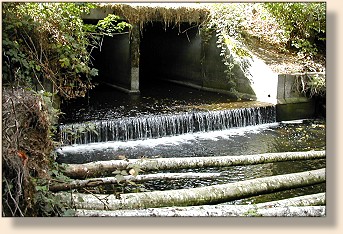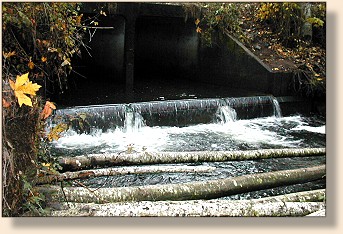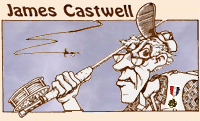|
It was just after the first of October, this year, I got a
phone call from Al, he said there was a big problem on the
creek. This is a local creek here, with a native run of Chum
Salmon due to enter the stream about the first week in November
and peak out by the 15th or so. Now Al had been 'hawking' the
stream for a few days, he likes to be on top of things when
it comes to catching salmon. This time it was a fortunate thing
he did. He said the water had come through the box culvert so fast
in the spring that it had dug a big pit on the downstream side
and the fish would not be able to jump up to the edge of the floor
of the culvert. If they did make it up, there was only about an
inch of water over the floor of it anyway, the things would have
to walk upstream.
It was only a few miles from me so I took off to get some pictures
and see for myself. He seemed to be right, that edge looked pretty
high to me too. Chum can jump but are not the greatest salmon at
it. As soon as I got home I called one of my friends on the
Washington State Fisheries Commission (WSFC). Not only was this a place
Al and I had fished for many years, but the fellow I called,
I knew had fished it too.

My friend at the WSFC said I would get a call from a field
officer very soon, I did, the next day. He knew of the stream
and the box culvert but did not know there had been a washout.
He explained that the culvert was the responsibility of the local
county road commission. Sorry to say, my heart sank and I told
him so. We had about two weeks to make a fix of some sort, at
least temporarily so the salmon could get up to the head waters
to spawn.
He said one way was to run two strings of sand-bags across the
stream, raising the water level in short stages, but there were
other ways to fix it as well. He assured me that he would see
that something would be done. I was somewhat relieved, but still
a bit shaky about the county getting it done, or doing it right.
In all fairness, due to the very high fluctuations of our tides
here, as much as twelve feet, there may have been enough water
flowing for the salmon to make it up the stream at high tide,
approximately one hour a day.
A few days later Al called me again on his cell-phone, he was
at the creek as was his daily habit now. He said some guys from
the county were there but they were going to put some iron rails
on the floor of the culvert or something. Guess it was supposed
to raise the level of water across the floor from one inch to
about four. They had busted up two beaver dams upstream also,
seemed to help water come down and let the fish get up. There
were going to be two openings in the rails at the lip of the
culvert on the downstream edge. The idea was that water would
plow through and over at those points and the fish could swim
right up the shaft of water. Well, it might work.
By Friday the eighth of November the state had counted over
11,000 chum salmon that made it over that lip and upstream. As I write
this on the eleventh, the salmon are still going up and there are
more on the way. This is a natural spawning run of native fish
and should be protected at all reasonable costs. There is fishing
allowed at the mouth, the estuary actually, you can keep two a
day. It is not a difficult fishery to handle and many learn how
to catch their first salmon at streams like this all over our
state.

I want to thank the County Road Commission, the fellow from the
state, my friend from the WSFC, but most importantly I want to
thank Al. If he had not called and got the ball rolling we could
have very easily lost a whole age class of native salmon.
One person did make a difference. Thanks Al.
~ James Castwell
|







